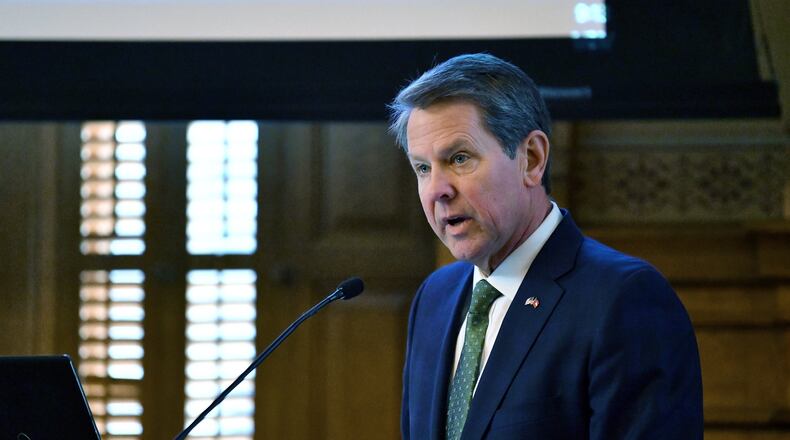Under Gov. Brian Kemp, Georgia is applying for two health care “waivers” from the federal government.
Kemp is taking aim at two big health care problems: the high cost of individual insurance premiums and Georgia’s unusually steep rate of uninsured adults.
The proposals could remake the way insurance works for some policyholders who are not covered by employer-based plans, about 6% of all Georgians, according to the Kaiser Family Foundation. Kemp’s aides believe it will increase the number of Georgians with insurance as well as the choices they have.
The ball is now in Washington’s court, at the offices of the U.S. Centers for Medicare and Medicaid Services, to decide what to do. A note of confusion on the two separate waivers: The private insurance waiver has itself just split in two. That’s three waiver pieces. We lay them out for you here:
What’s a waiver
A state seeks a waiver when it asks the federal government to set aside some rules to allow the state to tailor a federal health program to its own needs.
Georgia is seeking what are called 1115 and 1332 waivers because they affect the sections of federal law numbered 1115 (Medicaid) and 1332 (the Affordable Care Act exchange market for private insurance).
THE PRIVATE INSURANCE WAIVER
Names: The 1332 waiver; the State Relief and Empowerment Waiver.
This covers people buying individual plans in households making 100% to 400% of the federal poverty level. This is not about employer-sponsored plans.
PHASE I: The insurance subsidy
Names: Reinsurance.
- What
Kemp would use federal and state money to subsidize insurance companies’ costs on the individual market, reimbursing the companies for some of the bigger medical claims. The hope is that the insurance companies will allow that government subsidy to trickle down into premium prices, lowering people’s insurance bills. It’s hard to say whether insurance companies will pass on the entire amount of their savings, but experience in other states shows they’ve passed on enough to make a difference.
- When
Of all the waiver proposals, this one has the best chance of winning approval and is the least likely to face a court challenge, thanks to a tested track record in other states. Kemp and the Trump administration have just broken off this piece to stand apart from the rest of the waiver requests, in the hopes of getting it rolling for the insurance plan year that starts in January. That means Georgia shoppers could see lower plans when they start shopping at the start of open enrollment on Nov. 1.
The federal government is accepting public comment on this piece of the waiver until March 7.
- Who
The benefits would differ for different people.
The first thing to consider is income. People with higher incomes would benefit most from lower premiums. That’s partly because people with incomes between the poverty level and middle class already receive subsidies under the Affordable Care Act that lower the price of their policies. When people reach 400% of the federal poverty level — $103,000 per year for a family of four, for example — they are no longer eligible for subsidies and pay the full price of insurance premiums. So people at that income and above will benefit more from lower premiums.
Second, the benefits would vary by location. The Kemp administration is dividing the state into three groups that will receive different discounts. The biggest discount would go to some of the areas that have the most expensive premiums. The same insurance plan can cost more in rural Georgia than in metro Atlanta, so the smallest discount, estimated at 4.8%, would go to metro Atlanta, some other metro areas in the state and most of coastal Georgia. The counties along the state’s southern border would be among those seeing the biggest discounts: perhaps 25%, according to the number-crunchers who helped prepare the waiver. Across the state, the average discount could be about 10%.
- The cost
This subsidy is easily one of the most expensive of Kemp’s proposals, and that big gas tank of money to fuel the program is part of the reason it’s expected to work. The first year, the state estimates it would cost $368 million, including $104 million in state dollars.
PHASE II: “Copper plans,” a waitlist and more.
Names: Georgia Access Model.
This is where Kemp got creative. The state and the feds split this part of the private insurance waiver off from the first part because it’s going to take longer to consider.
In this part of the waiver application, Georgia is asking to take control of and completely overhaul the individual health insurance market.
Some critics say it’s illegal. The Kemp administration says it’s innovation.
Things it would do:
- Eliminate Georgians' access to the healthcare.gov website for choosing plans on the individual market. They would still be able to use private web brokers or go directly to insurance companies.
- Take state control of the federal subsidies that make private insurance affordable for low-income buyers on the healthcare.gov market. Kemp aides say that's about $2.7 billion.
- Allow the state to determine for each applicant whether he or she is a better fit for Medicaid or private insurance.
- Make changes in who gets the subsidies.
For the first time under Obamacare, every working-class-income person might not receive subsidies for insurance. There would be a funding cap, and if there wasn’t enough money, the state would start a waitlist. Right now, any individual who earns $16,000 a year can get a private insurance plan that’s so heavily subsidized by Obamacare it’s almost free. Under Kemp’s plan, if the state has reached its funding cap, that person would go on a waitlist and go without help to buy health insurance until he or she got off the list.
Kemp’s aides believe it won’t run out of money. An analysis from the center-left Brookings Institution in Washington and the University of Southern California claimed the Georgia waiver request has errors in calculation and will start with an annual deficit of at least $160 million.
People who would be newly eligible for subsidies include those who also get help paying for health insurance from their employers.
- Change how insurance plans are presented:
Web brokers would be allowed to present robust, standard health insurance plans alongside plans that offer less, such as short-term plans that don’t cover all the same benefits.
- Change what plans are offered:
For plans rolling out in 2022, Georgia would create new “Copper plans,” alongside the current “Gold” and “Silver” plans. With cheaper premiums, the Copper plans would cover the same things but with less money: Getting medical care would be more expensive for the policyholder than is currently allowed.
The state would also allow “Disease Management Plans” that focus their coverage more on a particular disease, such as diabetes or HIV.
A big question: Would the waiver proposal degrade the quality of insurance plans by saying they don’t have to cover pre-existing conditions and the “essential health benefits” such as psychiatric care and maternity care?
State officials have a clear answer: No. Those plans would still be required to cover those things.
However, when it comes to essential health benefits, the waiver proposal does ask the federal government to waive the requirement for the state that they be covered for the Disease Management Plans. Does that mean the state could change its mind in future years? It doesn’t say that but asks for “flexibility” in concentrating on the disease in question.
Also, under the Phase II part, Georgia would no longer require insurance companies to offer Gold and Silver plans.
- Goals: spurring innovation in health insurance, protecting people's access to full standard health plans and coverage for pre-existing conditions, and expanding coverage.
THE MEDICAID WAIVER
Names: The 1115 waiver; Pathways to Coverage.
Under this waiver request Georgia would provide Medicaid coverage to poor adults who meet certain qualifications.
- Who
Right now the people eligible for Medicaid in Georgia include all poor children; poor women who are pregnant or had a baby within the past 60 days; some elderly adults in nursing homes; and some disabled people who met federal standards to be declared disabled. That leaves most poor working-age adults without coverage. With the Medicaid waiver Kemp is taking aim at those who make between $0 and 100% of the federal poverty level, or $12,490 a year for an individual. (Above that income, the person may be eligible for a subsidized insurance plan.)
Kemp aides estimate there are about 408,000 adult Georgians in that income group who lack coverage. They forecast that perhaps 50,000 of them would meet the requirements to get coverage under their proposal.
The Medicaid waiver would offer coverage to any of those people if they perform certain activities at least 80 hours a month. First and foremost, that would be working at a job.
Other options include community service work at an approved charity or going to college.
Critics say most of the very poor already have some reason they’re not working. They may be caretaking for a family member with Alzheimer’s disease whom they can’t leave alone. They may be mentally ill and spurning the course of meetings required to get certified as disabled. They wouldn’t meet the waiver requirement under either of those circumstances.
Democrats say that’s why the state should fully expand Medicaid to all the state’s poor. From the governor’s perspective, though, the waiver does offer the chance at Medicaid to every poor Georgian, but without the cost of full Medicaid expansion.
- The cost
The state would probably bear just under one-third of the coverage costs, and the federal government would pick up the rest. Kemp’s office estimates total spending on patients at about $128 million the first year and $203 million the second year, after enrollment ramps up to the 50,000 range.
Kemp’s office has not estimated costs associated with the work/community engagement requirement. Other states that have tried to implement a work requirement reported costs ranging from $6 million to $272 million, according to the federal Government Accountability Office. Kemp aides say Georgia’s idea is unique and other states’ estimates don’t apply.
- The chances
Work requirements are currently the subject of a federal lawsuit.
- The goal
Kemp’s aides call this “Pathways” because the idea is that a person may start getting Medicaid with the work requirement but then get a job and have income. And if they make too much income to qualify for Medicaid, then so much the better: The state will move them up to a subsidized insurance plan.
About the Author
Keep Reading
The Latest
Featured




